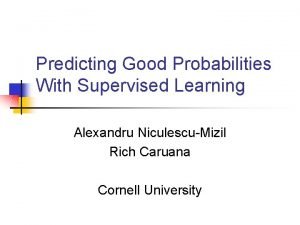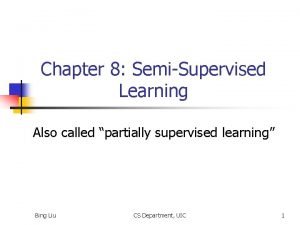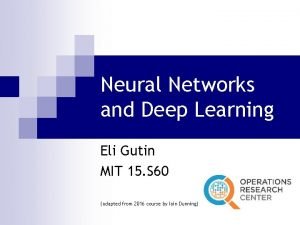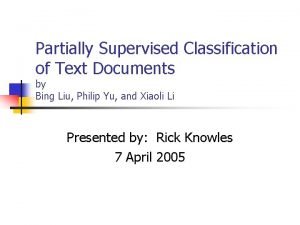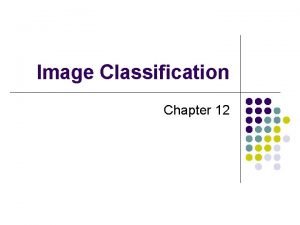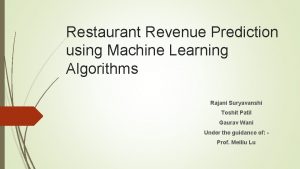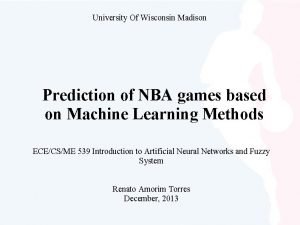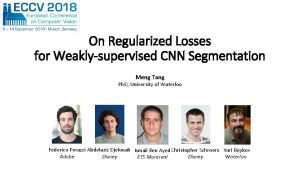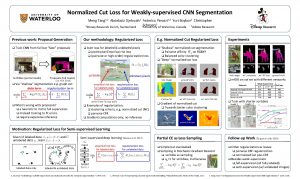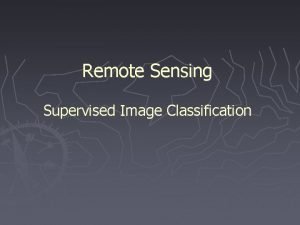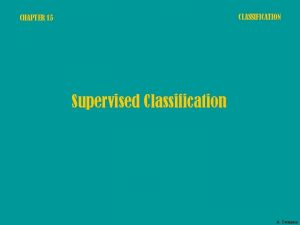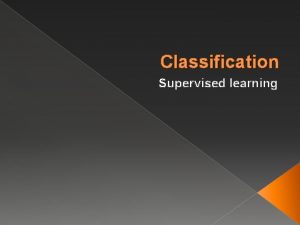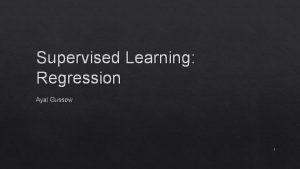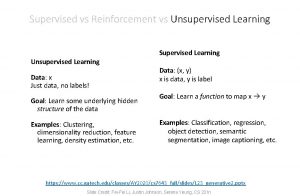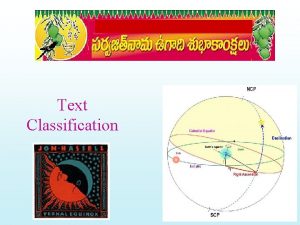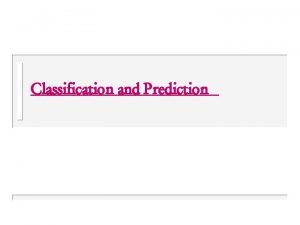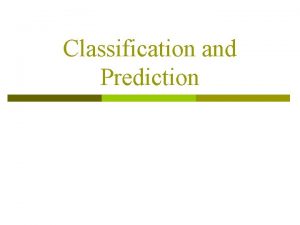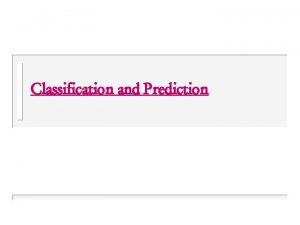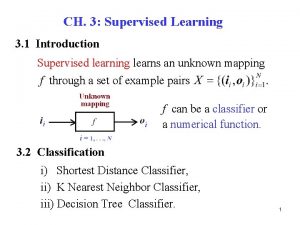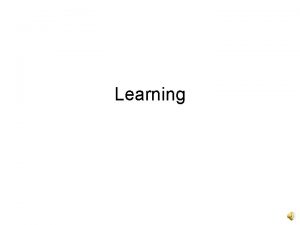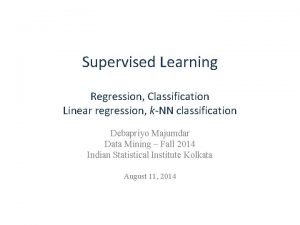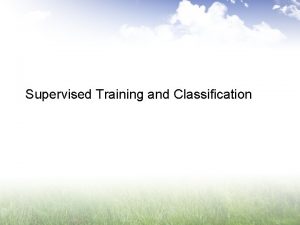Classification Prediction Classification Supervised Learning Use a training




















- Slides: 20

Classification / Prediction

Classification “Supervised Learning” Use a “training set” of examples to create a model that is able to predict, given an unknown sample, which of two or more classes that sample belongs to. ?

What we’ll cover • How to build a classifier. • How to evaluate a classifier. • Using Gene. Pattern to classify expression data.

What Is a Classifier • A predictive rule that uses a set of inputs (genes) to predict the values of the output (phenotype). • Known examples (train data) are used to build the predictive rule. • Goal: – Achieve high generalization (predictive) power. – Avoid over-fitting.

Classification Computational methodology Data Known Classes Assess Gene-Class Correlation Feature (Marker) Selection Build Classifier Test Classifier by Cross. Validation Evaluate Classifier on Independent Test Set

Classification Computational methodology Expression Data Known Classes Assess Gene-Class Correlation Feature Selection Regression Trees (CART) Weighted Voting Build Classifier k-Nearest Neighbors Support Vector Machines Test Classifier by Cross. Validation Evaluate Classifier on Independent Test Set

Classifiers Important issues: – Few cases, many variables (genes) – redundancy: many highly correlated genes. – noise: measurements are very imprecise. – feature selection: reducing p is a necessity. Avoid over-fitting.

K-nn Classifier Example: K=5, 2 genes, 2 classes project samples in gene space gene 2 class black class orange gene 1

K-nn Classifier Example: K=5, 2 genes, 2 classes project unknown sample gene 2 class black class orange ? gene 1

K-nn Classifier Example: K=5, 2 genes, 2 classes class black "consult" 5 closest neighbors: - 3 black - 2 orange Distance measures: • Euclidean distance gene 2 • 1 -Pearson correlation • … class orange ? gene 1

Support Vector Machine (SVM) Noble, Nat Biotech 2006

Weighted Voting new sample Mixture of Experts approach: – Each gene casts a vote for one of the possible classes. – The vote is weighted by a score assessing the reliability of the expert (in this case, the gene). – The class receiving the highest vote will be the predicted class. – The vote can be used as a proxy for the probability of class membership (prediction strength). Class 1 centroid g 1 g 2 … gi … gn-1 gn Class 2 centroid ? g 1 g 2 … gi … gn 1 gn Slonim et al. , RECOMB 2000

Class Prediction Computational methodology Expression Data Known Classes Assess Gene-Class Correlation Feature Selection Build Predictor Test Predictor by Cross. Validation Evaluate Predictor on Independent Test Set Regression Trees (CART) Weighted Voting k-Nearest Neighbors Support Vector Machines

Testing the Classifier • Evaluation on independent test set – Build the classifier on the train set – Assess prediction performance on test set. • Maximize generalization/Avoid overfitting. • Performance measure error rate = # of cases correctly classified total # of cases

Testing the Classifier • Evaluation on independent test set – What if we don’t have an independent test set? • Cross Validation (XV): – Split the dataset into n folds (e. g. , 10 folds of 10 cases each). – For each fold (e. g. , for each group of 10 cases), • train (i. e. , build model) on n-1 folds (e. g. , on 90 cases), • test (i. e. , predict) on left-out fold (e. g. , on remaining 10 cases). – Combine test results. – Frequently, leave-one-out XV (when small sample size).

Testing the Classifier Learning curves – leave one out cross validation ALL vs. MLL vs. AML

Testing the Classifier • Error rate estimate: – Evaluate on independent test set: • Best error estimate. – Cross Validation • Needed when small sample size and for model selection.

Classification Cookbook • Start by splitting data into train and test set (stratified). “Forget” about the test set until the very end. • Explore different feature selection methods and different classifiers on train set by XV. • Once the “best” classifier and best classifier parameters have been selected (based on XV) – Build a classifier with given parameters on entire train set. – Apply classifier to test set.

Classification Gene. Pattern methods • Split data into train and test set – Split. Dataset. Train. Test • Explore different feature selection methods and different classifiers on train set by CV. – CARTXValidation – KNNXValidation – Weighted. Voting. XValidation • Once the “best” classifier and best classifier parameters have been selected (based on CV) – CART – KNN – Weighted. Voting • Examine results: – Prediction. Reults. Viewer – Feature. Summary. Viewer

Classification Example
 Supervised learning dan unsupervised learning
Supervised learning dan unsupervised learning Contoh supervised learning
Contoh supervised learning On training targets for supervised speech separation
On training targets for supervised speech separation Alexandru niculescu-mizil
Alexandru niculescu-mizil Supervised learning pipeline
Supervised learning pipeline Partially supervised learning
Partially supervised learning Www.youtube.com
Www.youtube.com Supervised and unsupervised learning
Supervised and unsupervised learning Deep q network
Deep q network Interactive supervised classification
Interactive supervised classification Partially supervised classification of text documents
Partially supervised classification of text documents Supervised classification
Supervised classification Supervised classification
Supervised classification Avoiding discrimination through causal reasoning
Avoiding discrimination through causal reasoning Machine learning algorithms for restaurants
Machine learning algorithms for restaurants Stealing machine learning models via prediction apis
Stealing machine learning models via prediction apis Prediction of nba games based on machine learning methods
Prediction of nba games based on machine learning methods Stealing machine learning models via prediction apis
Stealing machine learning models via prediction apis Cuadro comparativo entre e-learning b-learning y m-learning
Cuadro comparativo entre e-learning b-learning y m-learning Normalized cut loss for weakly-supervised cnn segmentation
Normalized cut loss for weakly-supervised cnn segmentation Normalized cut loss for weakly-supervised cnn segmentation
Normalized cut loss for weakly-supervised cnn segmentation



